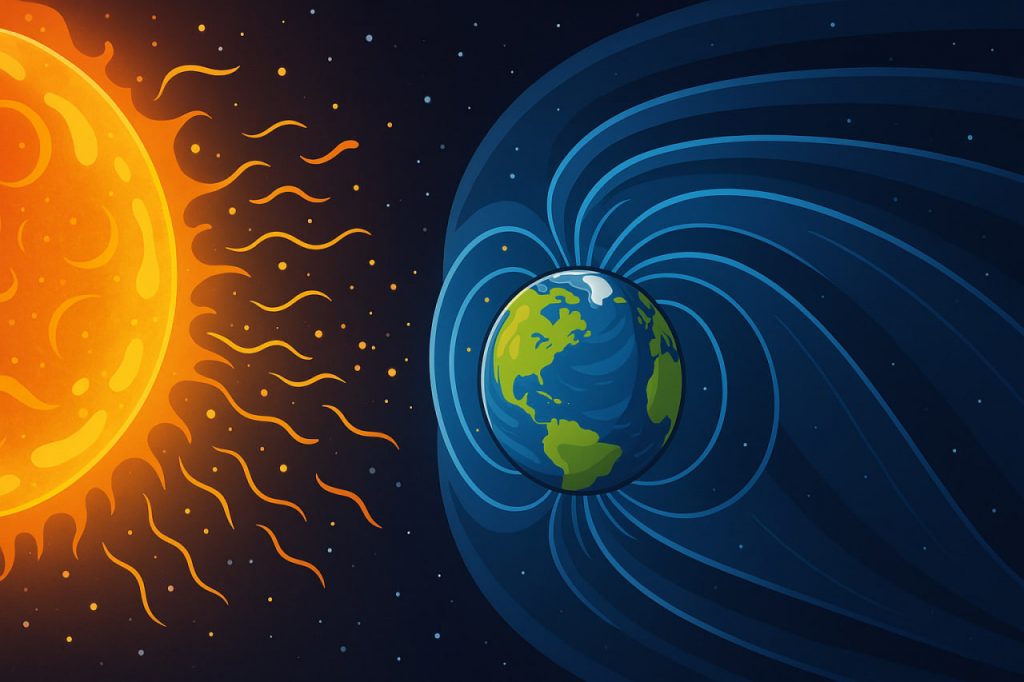The magnetosphere is a vast, invisible region around Earth that is dominated by the planet’s magnetic field. It plays a crucial role in protecting life on Earth by deflecting charged particles emitted by the Sun in the form of solar wind. Without this magnetic shield, harmful radiation would reach the surface, damaging the atmosphere and endangering life. Although the magnetosphere cannot be seen with the naked eye, it is one of the most essential natural systems safeguarding our planet.
How the Magnetosphere Is Formed
Earth’s magnetosphere is generated by the movement of molten iron and nickel in its outer core. This motion produces a magnetic field through a process known as the geodynamo. As this magnetic field extends into space, it interacts with the incoming solar wind. The pressure of the solar wind compresses the magnetosphere on the side facing the Sun and stretches it into a long tail on the side opposite the Sun. This interaction creates a complex, dynamic structure that is constantly changing with solar activity.
Structure and Components of the Magnetosphere
The magnetosphere is not uniform. It consists of several key regions:
- The bow shock, where the solar wind first encounters Earth’s magnetic field and slows down abruptly.
- The magnetosheath, a turbulent region between the bow shock and the magnetopause.
- The magnetopause, which marks the outer boundary of the magnetosphere.
- The plasmasphere, filled with low-energy charged particles trapped by the magnetic field.
- The radiation belts (also known as Van Allen belts), where high-energy particles are held in spiraling paths.
- The magnetotail, the elongated part on the night side, playing a major role in magnetic storms.
Each of these regions responds differently to solar conditions, and their interactions help regulate the flow of energy and particles near Earth.
Why the Magnetosphere Is So Important
The magnetosphere is essential for maintaining Earth’s habitability. It protects our atmosphere from being stripped away by solar wind, as has happened on planets like Mars. It also shields satellites, astronauts, and electronic systems from space radiation. When intense solar activity disturbs the magnetosphere, it can cause geomagnetic storms, leading to auroras, communication disruptions, and power grid failures. Understanding this system allows scientists to predict space weather and prepare for its effects on modern infrastructure.
How We Study the Magnetosphere
Scientists use satellites, space probes, and ground-based observatories to study the magnetosphere. Missions like NASA’s THEMIS, the Van Allen Probes, and the European Space Agency’s Cluster project have provided detailed data on the behavior of magnetic fields and charged particles in space. These observations help improve models of space weather and deepen our understanding of the Sun–Earth connection. New technologies continue to enhance our ability to monitor and protect against potential threats from solar activity.
Magnetospheres on Other Planets
Earth is not the only planet with a magnetosphere. Jupiter has the strongest one in the solar system, while Saturn, Uranus, and Neptune also possess magnetic fields and magnetospheres. Mars, on the other hand, lost its global magnetic field long ago, which is one reason it has a thin atmosphere. Studying other planetary magnetospheres provides clues about planetary evolution and habitability beyond Earth.
Glossary
- Magnetosphere: The region around a planet dominated by its magnetic field, protecting it from solar wind.
- Magnetic field: A force field created by moving electric charges, such as those in Earth’s core.
- Solar wind: A stream of charged particles emitted by the Sun.
- Geodynamo: The process by which Earth’s liquid outer core generates a magnetic field.
- Bow shock: The area where the solar wind first meets the magnetosphere and slows down.
- Magnetopause: The outer boundary of the magnetosphere.
- Radiation belts: Zones where high-energy particles are trapped by the magnetic field.
- Magnetotail: The stretched part of the magnetosphere on the night side of Earth.
- Space weather: The environmental conditions in space affected by the Sun’s activity.


